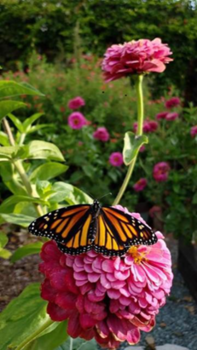by Mary Sotelo, Alameda Backyard Growers
Alameda Sun – Thursday, October 11, 2018

Butterflies are attracted to red, orange, yellow and purple flowers, but they need more than just plants to survive. All their needs can be satisfied in a small corner of any garden.
Sadly, the monarch butterfly population is declining. One of the primary reasons is the loss of open space where the monarchs’ host plants, milkweeds, grow. Alameda gardeners can help increase the monarchs’ numbers by building habitats in even the smallest of yards. Encourage monarchs to multiply by offering them food, drink, a place to stay and a milkweed patch where they can lay eggs.
The first step is to choose a spot in the garden that gets sunlight for at least half the day. Most plants that flower need at least some sun to flourish. Make sure the soil is free from rocks and, in Alameda’s soil, it is always good to add some compost. In my garden I have created a small habitat under a persimmon tree with just a couple of milkweed plants and other plants that butterflies and hummingbirds enjoy.
Monarchs need milkweed. Monarch caterpillars only feed on milkweed, and monarchs lay eggs only on milkweed. Once the monarchs find the plants, there can easily be eight or more caterpillars feeding on one plant, so more than one milkweed plant may be desired. If the caterpillars are eating a milkweed plant too quickly, gently move one or two caterpillars to another fresh plant.
After 10 to 14 days of munching away on milkweed leaves, the monarch caterpillar forms a chrysalis where it will stay for two weeks before it emerges as a beautiful monarch butterfly.
Milkweed contains toxins that the caterpillars ingest, causing the caterpillars and butterflies to be poisonous to most predators. It’s a good idea to plant milkweed species native to California, as the alkaloids from non-native milkweeds may not deter the local predators as effectively.
Native monarchs also may not tolerate the non-native alkaloids well.
Adult butterflies will need nectar plants for food. There are a variety of these plants to select. Some common plants are: cone flower, yarrow, columbine, borage, salvia, sage and lantana. Check plant tags to see if butterflies like them. Choose plants that bloom at different times starting in late spring and throughout the summer to provide nectar throughout the year. Butterflies are attracted to red, orange, yellow and purple flowers.
Monarchs need more than just plants. They also need a few flat rocks for sunning and resting and cool shady spots to help regulate their temperatures. It’s always nice to provide a shallow dish where they can “puddle” or drink. Adding some coarse sand to the dish will give them the minerals they need.
Do not use pesticides or insecticides in the garden as these are very harmful to monarchs. Fortunately, creating these habitats is not as hard as it may seem. Seeing beautiful monarchs flitting all over the garden is a rewarding experience, knowing that providing a haven for them is a small part in helping them survive.
